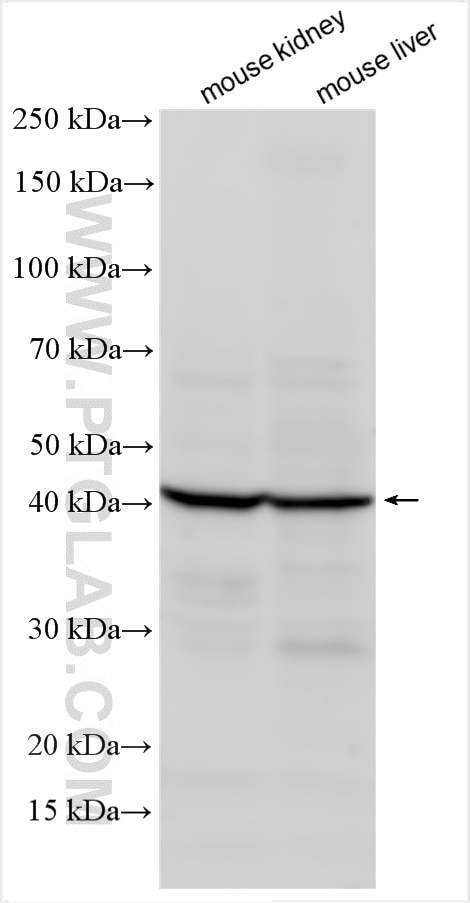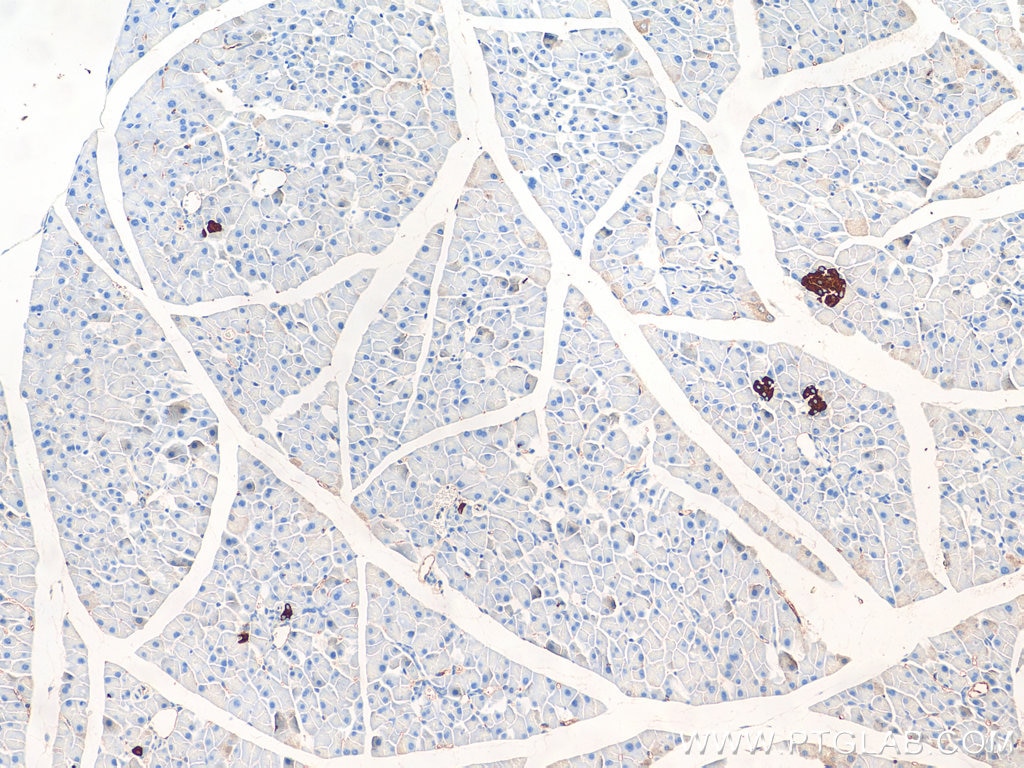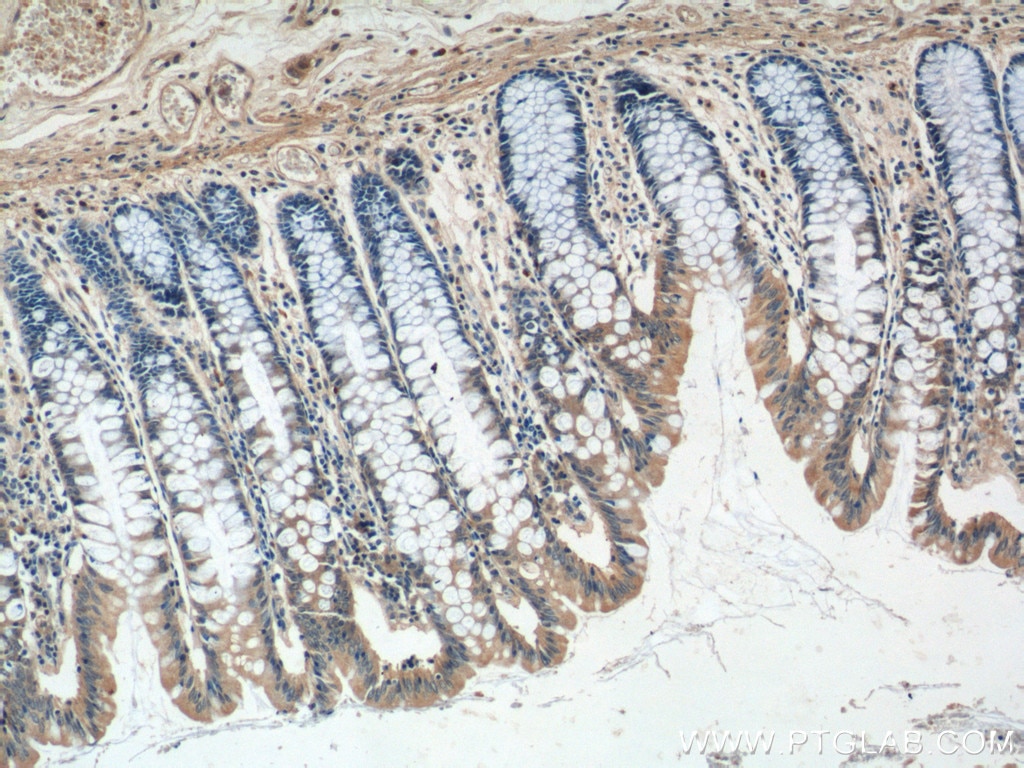Tested Applications
| Positive WB detected in | mouse kidney tissue, mouse liver tissue |
| Positive IHC detected in | mouse pancreas tissue, human colon tissue, human pancreas tissue Note: suggested antigen retrieval with TE buffer pH 9.0; (*) Alternatively, antigen retrieval may be performed with citrate buffer pH 6.0 |
Recommended dilution
| Application | Dilution |
|---|---|
| Western Blot (WB) | WB : 1:500-1:1000 |
| Immunohistochemistry (IHC) | IHC : 1:250-1:1000 |
| It is recommended that this reagent should be titrated in each testing system to obtain optimal results. | |
| Sample-dependent, Check data in validation data gallery. | |
Published Applications
| KD/KO | See 1 publications below |
| WB | See 3 publications below |
| IHC | See 1 publications below |
| IF | See 1 publications below |
Product Information
20146-1-AP targets GPR81 in WB, IHC, IF, ELISA applications and shows reactivity with human, mouse samples.
| Tested Reactivity | human, mouse |
| Cited Reactivity | human, mouse, rat |
| Host / Isotype | Rabbit / IgG |
| Class | Polyclonal |
| Type | Antibody |
| Immunogen |
CatNo: Ag13682 Product name: Recombinant human GPR81 protein Source: e coli.-derived, PGEX-4T Tag: GST Domain: 250-346 aa of BC066881 Sequence: SACDPSVHGALHITLSFTYMNSMLDPLVYYFSSPSFPKFYNKLKICSLKPKQPGHSKTQRPEEMPISNLGRRSCISVANSFQSQSDGQWDPHIVEWH Predict reactive species |
| Full Name | G protein-coupled receptor 81 |
| Calculated Molecular Weight | 346 aa, 39 kDa |
| Observed Molecular Weight | 39 kDa |
| GenBank Accession Number | BC066881 |
| Gene Symbol | GPR81 |
| Gene ID (NCBI) | 27198 |
| RRID | AB_2878647 |
| Conjugate | Unconjugated |
| Form | Liquid |
| Purification Method | Antigen affinity purification |
| UNIPROT ID | Q9BXC0 |
| Storage Buffer | PBS with 0.02% sodium azide and 50% glycerol, pH 7.3. |
| Storage Conditions | Store at -20°C. Stable for one year after shipment. Aliquoting is unnecessary for -20oC storage. 20ul sizes contain 0.1% BSA. |
Background Information
GPR81 (G protein-coupled receptor 81) is one of a large family of GPRs with low affinity for hydroxy-carboxylic acid structure ligands (PMID: 24657625). Lactate functions as a signaling molecule by serving as an agonist for the GPR81, involving both autocrine and paracrine mechanisms (PMID: 31836453). Moreover, A higher molecular mass band (∼60 kDa) is present in the brain and adipose tissue. This band is also strong in the transfected HeLa cells but weak in native HeLa cells and is therefore probably a form of GPR81, possibly a glycosylated form of the receptor (PMID: 23696276).
Protocols
| Product Specific Protocols | |
|---|---|
| IHC protocol for GPR81 antibody 20146-1-AP | Download protocol |
| WB protocol for GPR81 antibody 20146-1-AP | Download protocol |
| Standard Protocols | |
|---|---|
| Click here to view our Standard Protocols |
Publications
| Species | Application | Title |
|---|---|---|
Life Sci Aerobic exercise regulates GPR81 signal pathway and mediates complement- microglia axis homeostasis on synaptic protection in the early stage of Alzheimer's disease | ||
Front Oncol Lactate increases tumor malignancy by promoting tumor small extracellular vesicles production via the GPR81-cAMP-PKA-HIF-1α axis
| ||
Sci Rep PET-CT and RNA sequencing reveal novel targets for acupuncture-induced lowering of blood pressure in spontaneously hypertensive rats. | ||
Placenta Immunohistochemical localization of HCA1 receptor in placenta in presence of fetal growth restriction | ||
Adv Sci (Weinh) Breed-Driven Microbiome Heterogeneity Regulates Intestinal Stem Cell Proliferation via Lactobacillus-Lactate-GPR81 Signaling |
















